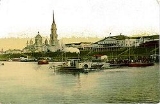
Rybinsk
Encyclopedia
Rybinsk is the second largest city of Yaroslavl Oblast
, Russia
, which lies at the confluence
of the Volga
and Sheksna River
s. Population: It is served by Rybinsk Staroselye airport.
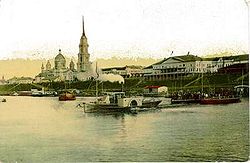 Rybinsk is one of the oldest Slavic settlements on the Volga River. The place was first noticed by chroniclers in 1071 as Ust-Sheksna, i.e. "the mouth of the Sheksna". For the next four centuries, the settlement was referred to alternatively as Ust-Sheksna or Rybansk. Since 1504, it was mentioned in documents as Rybnaya Sloboda (literally: "the fishing village"). The name is explained by the fact that the settlement supplied the Muscovite court with choice sturgeon
Rybinsk is one of the oldest Slavic settlements on the Volga River. The place was first noticed by chroniclers in 1071 as Ust-Sheksna, i.e. "the mouth of the Sheksna". For the next four centuries, the settlement was referred to alternatively as Ust-Sheksna or Rybansk. Since 1504, it was mentioned in documents as Rybnaya Sloboda (literally: "the fishing village"). The name is explained by the fact that the settlement supplied the Muscovite court with choice sturgeon
s and sterlet
s.
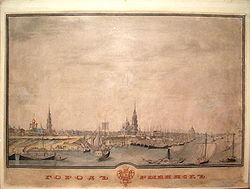 In the 17th century, when the sloboda
In the 17th century, when the sloboda
was capitalizing on the trade of the Muscovy Company
with Western Europe, it was rich enough to build several stone churches, of which only one survives to the present. More old architecture may be found in the neighborhood, including the very last of Muscovite three-tented churches (in the Alexandrov Hermitage) and the Ushakov
family shrine (on the Epiphany Island).
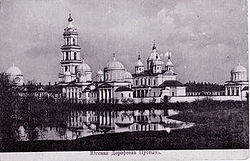 In the 18th century, the sloboda continued to thrive on the Volga trade. Catherine the Great granted Rybnaya Sloboda municipal rights and renamed it into the town of Rybinsk. It was a place where the cargo was reloaded from large Volga vessels to smaller boats capable of navigating in the shallow Mariinsk Canal system, which connects the Russian hinterland with the Baltic Sea
In the 18th century, the sloboda continued to thrive on the Volga trade. Catherine the Great granted Rybnaya Sloboda municipal rights and renamed it into the town of Rybinsk. It was a place where the cargo was reloaded from large Volga vessels to smaller boats capable of navigating in the shallow Mariinsk Canal system, which connects the Russian hinterland with the Baltic Sea
. With the population of 7,000, the town of Rybinsk daily accommodated up to 170,000 sailors and up to 2,000 river vessels. Consequently, the local river port became known as the "capital of barge-haulers".
The town's most conspicuous landmark, the Neoclassical
Savior-Transfiguration Cathedral, was constructed on the Volga riverside from 1838 until 1851. It was built to a design that the Dean of the Imperial Academy of Arts
, Avraam Melnikov
, had prepared for Saint Isaac's Cathedral
in St Petersburg. After Melnikov lost the contest for the best project of St Isaac's Cathedral to Auguste de Montferrand
, he sold his grandiose design to the municipal authorities of Rybinsk.
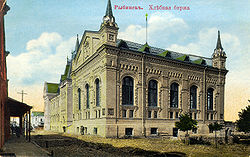 As a trade capital of the Upper Volga, Rybinsk formerly attracted scores of foreigners, who built a Lutheran church and an imposing Roman Catholic cathedral, said to be the tallest on the Volga. There is also the Nobel Family Museum, documenting the operations of that illustrious Swedish family in Imperial Russia. Early film moguls Nicholas Schenck
As a trade capital of the Upper Volga, Rybinsk formerly attracted scores of foreigners, who built a Lutheran church and an imposing Roman Catholic cathedral, said to be the tallest on the Volga. There is also the Nobel Family Museum, documenting the operations of that illustrious Swedish family in Imperial Russia. Early film moguls Nicholas Schenck
and Joseph Schenck
were born in the town, and there is a grand 18th-century mansion of the Mikhalkov family, whose living members include Sergey Mikhalkov
, Nikita Mikhalkov
, and Andron Konchalovsky.
) in 1946, back to Rybinsk in 1957, to Andropov (after Yuri Andropov
) in 1984, and back to Rybinsk in 1989.
The most important industries of modern Rybinsk are aircraft engine manufacturing
and a hydroelectric power station. As the experts warn, the giant Rybinsk dam, which holds the Rybinsk Reservoir
(formerly touted as the largest man-made body of water on Earth) places the town in the imminent danger of the dam breaking and the reservoir flooding the city.
Yaroslavl Oblast
Yaroslavl Oblast is a federal subject of Russia , which is located in the Central Federal District, surrounded by Tver, Moscow, Ivanovo, Vladimir, Kostroma, and Vologda Oblasts. This geographic location affords the oblast the advantages of proximity to Moscow and St. Petersburg...
, Russia
Russia
Russia or , officially known as both Russia and the Russian Federation , is a country in northern Eurasia. It is a federal semi-presidential republic, comprising 83 federal subjects...
, which lies at the confluence
Confluence
Confluence, in geography, describes the meeting of two or more bodies of water.Confluence may also refer to:* Confluence , a property of term rewriting systems...
of the Volga
Volga River
The Volga is the largest river in Europe in terms of length, discharge, and watershed. It flows through central Russia, and is widely viewed as the national river of Russia. Out of the twenty largest cities of Russia, eleven, including the capital Moscow, are situated in the Volga's drainage...
and Sheksna River
Sheksna River
The Sheksna is a river in Belozersky, Kirillovsky, Sheksninsky, and Cherepovetsky Districts of Vologda Oblast in Russia. It is a left tributary of the Volga River. It is long, and the area of its basin...
s. Population: It is served by Rybinsk Staroselye airport.
Early history

Sturgeon
Sturgeon is the common name used for some 26 species of fish in the family Acipenseridae, including the genera Acipenser, Huso, Scaphirhynchus and Pseudoscaphirhynchus. The term includes over 20 species commonly referred to as sturgeon and several closely related species that have distinct common...
s and sterlet
Sterlet
The sterlet is a common Eurasian species of sturgeon, one of the smaller species of sturgeon. It is a common domestic species in the UK and Europe and an angling species all over the world...
s.

Sloboda
Sloboda was a kind of settlement in the history of Russia, Belarus and Ukraine. The name is derived from the early Slavic word for "freedom" and may be vaguely translated as "free settlement"....
was capitalizing on the trade of the Muscovy Company
Muscovy Company
The Muscovy Company , was a trading company chartered in 1555. It was the first major chartered joint stock company, the precursor of the type of business that would soon flourish in England, and became closely associated with such famous names as Henry Hudson and William Baffin...
with Western Europe, it was rich enough to build several stone churches, of which only one survives to the present. More old architecture may be found in the neighborhood, including the very last of Muscovite three-tented churches (in the Alexandrov Hermitage) and the Ushakov
Fyodor Fyodorovich Ushakov
Fyodor Fyodorovich Ushakov was the most illustrious Russian naval commander and admiral of the 18th century.- Life and naval career :...
family shrine (on the Epiphany Island).
Golden age

Baltic Sea
The Baltic Sea is a brackish mediterranean sea located in Northern Europe, from 53°N to 66°N latitude and from 20°E to 26°E longitude. It is bounded by the Scandinavian Peninsula, the mainland of Europe, and the Danish islands. It drains into the Kattegat by way of the Øresund, the Great Belt and...
. With the population of 7,000, the town of Rybinsk daily accommodated up to 170,000 sailors and up to 2,000 river vessels. Consequently, the local river port became known as the "capital of barge-haulers".
The town's most conspicuous landmark, the Neoclassical
Neoclassical architecture
Neoclassical architecture was an architectural style produced by the neoclassical movement that began in the mid-18th century, manifested both in its details as a reaction against the Rococo style of naturalistic ornament, and in its architectural formulas as an outgrowth of some classicizing...
Savior-Transfiguration Cathedral, was constructed on the Volga riverside from 1838 until 1851. It was built to a design that the Dean of the Imperial Academy of Arts
Imperial Academy of Arts
The Russian Academy of Arts, informally known as the St. Petersburg Academy of Arts, was founded in 1757 by Ivan Shuvalov under the name Academy of the Three Noblest Arts. Catherine the Great renamed it the Imperial Academy of Arts and commissioned a new building, completed 25 years later in 1789...
, Avraam Melnikov
Avraam Melnikov
Abram or Avraam Melnikov was a Russian Neoclassical architect associated with the late phase of the Empire style. His teachers at the Imperial Academy of Arts included Andreyan Zakharov. He graduated with a gold medal and went to further his studies in Italy...
, had prepared for Saint Isaac's Cathedral
Saint Isaac's Cathedral
Saint Isaac's Cathedral or Isaakievskiy Sobor in Saint Petersburg, Russia is the largest Russian Orthodox cathedral in the city...
in St Petersburg. After Melnikov lost the contest for the best project of St Isaac's Cathedral to Auguste de Montferrand
Auguste de Montferrand
Auguste de Montferrand was a French Neoclassical architect who worked primarily in Russia. His two best known works are the Saint Isaac's Cathedral and the Alexander Column in St. Petersburg.-Family:...
, he sold his grandiose design to the municipal authorities of Rybinsk.

Nicholas Schenck
Nicholas M. Schenck was a motion picture mogul and impresario.One of seven children, Schenck was born to a Jewish household in Rybinsk, a Volga River village in Tsarist Russia...
and Joseph Schenck
Joseph Schenck
Joseph Michael Schenck was a pioneer executive who played a key role in the development of the United States film industry.Born in Rybinsk, Yaroslavl Oblast, Russia to a Jewish household, he and his family-including younger brother Nicholas- emigrated to New York City in 1893, he and Nicholas...
were born in the town, and there is a grand 18th-century mansion of the Mikhalkov family, whose living members include Sergey Mikhalkov
Sergey Mikhalkov
Sergey Vladimirovich Mikhalkov was a Soviet and Russian author of children's books and satirical fables who had the opportunity to write the lyrics of his country's national anthem on three different occasions, spanning almost 60 years.-Life and career:...
, Nikita Mikhalkov
Nikita Mikhalkov
Nikita Sergeyevich Mikhalkov is a Soviet and Russian filmmaker, actor, and head of the Russian Cinematographers' Union.Mikhalkov was born in Moscow into the distinguished, artistic Mikhalkov family. His great grandfather was the imperial governor of Yaroslavl, whose mother was a Galitzine princess...
, and Andron Konchalovsky.
20th century
In the Soviet years, Rybinsk continued its impressive record of renamings, for it changed its name four times: to Shcherbakov (after Aleksandr ShcherbakovAleksandr Shcherbakov
Aleksandr Sergueyevich Shcherbakov , was a founding member of the Soviet Writers' Union, along with Maxim Gorky. Following the latter's death in 1936, Shcherbakov was transferred from his role as First Secretary to the lower role of Secretary of the Leningrad Regional Committee where he reported...
) in 1946, back to Rybinsk in 1957, to Andropov (after Yuri Andropov
Yuri Andropov
Yuri Vladimirovich Andropov was a Soviet politician and the General Secretary of the Communist Party of the Soviet Union from 12 November 1982 until his death fifteen months later.-Early life:...
) in 1984, and back to Rybinsk in 1989.
The most important industries of modern Rybinsk are aircraft engine manufacturing
NPO Saturn
NPO Saturn is a Russian aircraft engine manufacturer, formed from the mergers of Rybinsk and Lyul'ka-Saturn . Saturn's engines power many former Eastern Bloc aircraft, such as the Tupolev Tu-154. Saturn holds a 50% stake in the PowerJet joint venture with Snecma...
and a hydroelectric power station. As the experts warn, the giant Rybinsk dam, which holds the Rybinsk Reservoir
Rybinsk Reservoir
Rybinsk Reservoir , informally called the Rybinsk Sea, is a water reservoir on the Volga River and its tributaries Sheksna and Mologa, formed by Rybinsk Hydroelectric Station dam, located on the territories of Tver, Vologda, and Yaroslavl Oblasts. At the time of its construction, it was the largest...
(formerly touted as the largest man-made body of water on Earth) places the town in the imminent danger of the dam breaking and the reservoir flooding the city.
External links
- Official website of Rybinsk
- http://www.rybinsk.info/
- http://ryb.ru/
- http://www.rybinsk.ru/photoalbum/arch.htm
- Rybinsk Museum-Preserve of History, Architecture and Art, founded in 1910, is one of the greatest museums of the Upper Volga

